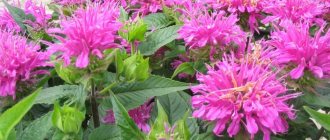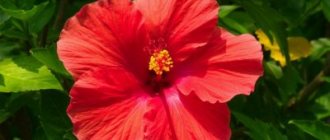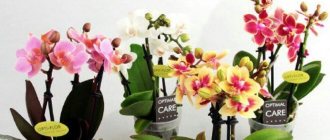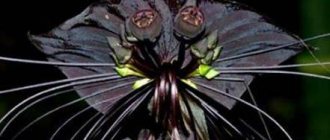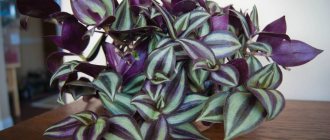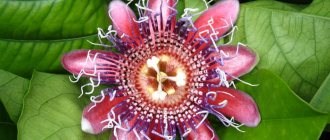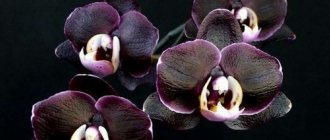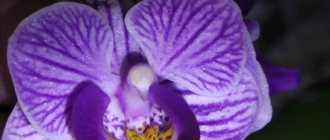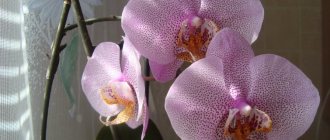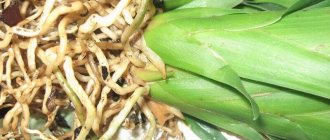How it appeared, where it usually grows
This orchid is a hybrid and belongs to the Phalaenopsis family. Brought out by breeders. It got its name because of its ability to produce many flowers at the same time. Like all representatives of orchids, it belongs to the ancient orchids family, whose homeland is southeast Asia and Australia. For habitat it chooses tree trunks, rocks, shady gorges and mountain forests.
This is interesting: breeding work lasted more than a century, and now each of us can enjoy this flower at home. There is no longer any need to fear that the conditions will not be right and he will die.
Names of varieties, photos
They come in a wide variety of colors and how the shades are combined. The most popular are phalaenopsis plants with delicate or bright, contrasting buds. It’s easy to see their beauty by looking at the photo.
Multiflora white (Phalaenopsis Multiflora white)
The flowers are small, pure white, the petals are uniform. The middle is soft yellow.
Multiflora purple (Phalaenopsis Multiflora purple)
As you can easily guess from the name, this specimen is lilac in color, slightly lighter in the center. The buds sparkle in the light.
Phalaenopsis Multiflora Sannion
An interesting orchid reminiscent of Phalaenopsis Wildcat. The predatory coloring is similar to the skin of a leopard. The specks are small, pink-violet, the middle is lilac, uniform. The petals are usually white, but due to the pattern they may appear purple from a distance.
Santos
This subspecies is close in color to Phalaenopsis Multiflora white, and is just as delicate. But the buds do not have a very pronounced lavender tint and are more crowded.
Black night
Mesmerizing with its contrast: the purple of the main color emphasizes the milky white middle. Unlike its counterparts, a blooming flower resembles a triangle in shape. There are many other names.
This is interesting: the phalaenopsis orchid easily changes the shade of its roots - from greenish when they are wet to silver when dry.
External characteristics
An adult plant in full bloom has 4-6 large, shiny leaves up to 40 cm long. Some varieties have up to 12 pieces.
The maximum length of the peduncle under ideal conditions reaches 60 cm. It is a branched raceme with many flowers and buds, which is constantly growing.
The shape of the flower corolla in most multiflora hybrids resembles the classic flower of a standard phalaenopsis, the diameter of which is much smaller - on average 2-3 cm, up to a maximum of 6 cm.
Photo of phalaenopsis multiflora flowers.
This group of hybrids can be painted in all colors possible for orchids. The most common color groups:
- white;
- pink and all shades of lilac;
- yellow, golden, peach, coral;
- coral, red.
Options for color combinations can be very diverse.
Bloom
Multiflora is a big fan of decorating itself with buds. They bloom in winter, and especially abundantly in summer. This species is very rarely and does not remain dormant for long. Before flowering, strictly monitor the temperature, do not let it drop below +27 °C. The nighttime difference should not exceed 3-5 degrees. An additional light source is also necessary, since natural light may not be enough.
Then move the pot to a cooler place. This will force the orchid to enter a new period of flowering. After one and a half to two months, return the plant to its old place and reduce watering.
What to do if it doesn't bloom
Stimulate by lowering the daytime temperature to +22 °C. Night temperature should not differ by more than four degrees. Under no circumstances allow the thermometer to drop below +20 °C during the day - in this case, diseases and dropping of buds are possible. You also need to trim the faded stem to the second eye from the bottom.
Caring for the Multiflora orchid at home
This orchid is a hybrid, and it does not need to be created in the same conditions as in a greenhouse or tropical forest. It can be noted that Multiflora will not need any more care than other phalaenopsis.
Place
Correct: bright during the day, with artificial light sources in the evening, warm enough.
The chosen one is incorrect: subject to drafts or dry air (for example, near a battery), in direct sunlight, or, on the contrary, excessively gloomy.
Important: if leaves and petals fall off, move the plant to a brighter place. If the orchid turns yellow, protect it from exposure to bright sun.
Soil and pot
Orchid requires special soil. You can buy it in a store or make it yourself. To do this you will need (in order of filling the container):
- polystyrene foam or construction expanded clay as drainage;
- pine bark, divided into small pieces that must be disinfected with boiling water;
- charcoal;
- sphagnum, also known as peat moss (to cover the substrate and retain moisture).
You will need a container for planting with drainage holes; they should be located along the entire bottom and on the walls of the lower part of the pot. Choose depending on the size of the root system of your orchid. It should be positioned freely, but in such a way that there is no extra empty space left. Give preference to low specimens without narrowing, made of transparent material.
Temperature and humidity
The flower should be warm. In any season, the thermometer cannot drop below +23 °C...+25 °C during the day. Avoid excessively sudden changes in night temperature, optimally no more than 7 degrees.
Humidity is also important for Multiflora. Keep it at 60%. A fluctuation of 10% in both directions is acceptable. If the house is too damp, do not forget about timely ventilation, having first protected your pet from drafts.
Light
This plant is accustomed to good light. In winter, when evening comes quickly, turn on the lamps. In summer, take care to shade the windows with a light cloth so that the orchid does not suffer from too much sun.
Watering
It is carried out with clean water at room temperature, which during the process should only fall on the ground. If leaves are affected, they should be carefully dried with a paper towel to prevent rotting.
Follow the procedure correctly:
- lower the container with the flower into a basin of water, hold for no more than one minute;
- then let it drain and empty the tray of excess moisture.
Advice: it is better to water in the morning, once a week. If the weather is hot, spraying with a spray bottle is acceptable.
Fertilizers
You need to feed Multiflora strictly according to the instructions, it is important not to overdo it. Do this no more than once a week, along with watering, after reading the instructions on the package.
If your plant is in the growing season, fertilize with a mixture of calcium nitrate, urea and magnesium sulfate in a ratio of 2:6:1. If it is winter, reduce the concentration by half.
Transfer
This is done no more often than once every couple of years, when the roots have grown enough and the pot becomes too small for them. Changing the soil to fresh one is also very important for the future life of the plant. In no case should you do this during the flowering period.
Wait until all the buds have dropped; there should be no buds on the stem either. When you remove the orchid from the pot, remove the damaged parts and treat the cuts with ground cinnamon or charcoal. Before placing Multiflora in fresh substrate, make sure that the roots are dry.
Distinctive characteristics of the species
Phalaenopsis Big Lip is a large-flowered orchid. The flowers of all phalaenopsis have the same structure - two circles of petals: the outer (sepals) and the inner (petals). There is also a lower petal called the lip (labellum). It is designed to make it easier for insects to penetrate the flower.
Main characteristics of the variety:
- Short thick stem.
- There are aerial roots, characteristic of epiphytes, covered with a layer of velamen.
- The leaves are wide, dark green, and do not change color throughout life.
- Peduncles are long, up to 70 cm, directed upward.
- The flowers are quite large, up to 10 cm, the lower petal is large, unfolded, almost flat.
- Flowering is long, up to 2–2.5 months, flowering is possible 2 times a year, the dormant period is up to 6 months.
- With proper care, they can begin to bloom at any time of the year after a period of dormancy.
- The colors vary depending on the subspecies; they can have contrasting colors, as well as patterns on the petals in the form of dots or veins.
Reproduction
In nature, phalaenopsis is easily propagated by seeds. It is much more difficult to do this at home, so it is preferable to use air shoots or children.
Process description:
- When there are no buds left on the plant, a cut is made on the dried peduncle 1-1.5 cm above the swelling bud.
- After the baby appears, wait for it to form its own root system no shorter than 5 cm and carefully separate the young plant from the mother one.
- Replant in a small pot with fresh substrate and care as usual.
Orchid babies can be seen in the photographs.
general information
In modern flower shops you can find many types of Phalaenopsis, which is explained by its extraordinary popularity and decorative value. Due to their long flowering period and variety of colors, these beautiful representatives of orchids are often used to decorate halls for various events, store windows and home collections.
From a distance, Phalaenopsis flowers resemble butterflies. Their name speaks about this. Translated from Greek, it means “like a moth.” Phalaenopsis are unpretentious in care and easily adapt to home living conditions.
Pests and diseases
Most often, Phalaenopsis Multiflora suffers from mites, aphids, snails and slugs, as well as gray rot. Each of them has been well studied and is successfully removed with specially designed insecticides.
Processing process:
- Remove the flower from the pot and rinse it thoroughly in the shower.
- Change the soil to fresh one, because it may contain pest larvae.
- Repeat the treatment several times (taking a week's break) until the threat is completely eliminated.
If the roots have rotted, the buds have begun to fall off and the leaves have turned yellow, it is most likely due to improper care. It is this that is the main cause of orchid diseases. In this case, it is worth carefully reviewing the conditions of keeping the pet.
Important: if the plant is new, it needs a month's quarantine and regular inspections for the presence of insects and diseases. If you have several orchids, and one is sick, you need to isolate it from the rest until complete recovery.
Varieties
In modern floriculture, several varieties are very popular, which differ in color, size of inflorescences and height.
Venice
The translated name is Multiflora Venice White.
The orchid is distinguished by its miniature size - the height of the peduncle is 38-40 cm. The leaves are light green, leathery, oval-elongated in shape. The length of the leaf plate is 20-25 cm.
The inflorescences are medium - 6-8 cm in diameter, consisting of snow-white petals. The core is yellow with small lilac splashes.
In adult plants, several arrows are formed (4-5 pieces), which produce 30-40 buds.
This variety requires a window sill with diffused daylight and protection from the scorching sun. The optimal temperature is 20-22°C. During flowering, it needs support, since the delicate peduncles are very fragile and can break off under the weight of the buds.
Spring
This hybrid, with a height of 50 to 60 cm, has an unusual color. Medium-sized inflorescences (6-8 cm in diameter) consist of pale yellow petals covered with longitudinal burgundy stripes. The pistil is a rich crimson color.
The flower stalks are thick, dark green, the plant forms 6-7 pieces. The leaves are emerald, dense, leathery, grow vertically, slightly turned outward.
Flowering is long-lasting and is ensured by the continuous growth of shoots and the formation of new buds.
Conditions of detention: good access to daylight for 10 hours. Requires protection from the scorching sun and periodic spraying. The temperature during the day is 20-22°C, at night about 10°C.
Soft Cloud
Pronounced Soft Cloud.
The main difference of this variety is the abundant and lush flowering that forms at the top of the shoots.
A blooming white orchid creates the effect of a snow-white cloud.
The inflorescences are small - 5-6 cm in diameter, the petals are white, the center is pale yellow. From 5 to 10 thin, dark green peduncles are formed on one plant. Each of them contains from 30 to 50 buds.
Orchids need light
The leaves are dense, emerald green, up to 6 pieces on one rosette. Flowering lasts for several months. Faded inflorescences are replaced by newly blooming flowers.
Requires good and diffuse lighting during the day, daily spraying, which provides high humidity. Temperature: 19-20°C during the day, 9-10°C at night.
Dragon
A delicate plant with beautiful salmon-colored inflorescences attracts the attention of many gardeners. The size of the flowers is 6-7 cm in diameter, the number in one bud is 5 pcs. The pistil is lilac, the base of the petals is covered with small dark pink specks.
One orchid forms 4-5 flower stalks, up to 50 cm long. The leaves are dense, green, and grow horizontally. Flowering is long - from three to five months.
Maintenance conditions: regular irrigation, diffused daylight for 10 hours, temperature readings during the day are 20-21°C, at night they are reduced to 8-9°C.
Cx322
This variety with variegated petals cannot be confused with any other. The flowers are medium in size (5-6 cm) and consist of 5 petals of a pale lilac tone, covered with purple spots. The base is burgundy.
The length of the flower arrow is 50-55 cm. 5-6 pieces are formed on one adult plant. The leaves are emerald, thick, grow vertically, 7-8 pieces develop in one rosette.
Flowering is long-lasting - after some buds fade, others begin to open; it lasts 4-5 months.
Conditions: moderate humidity (60-65%) due to daily spraying, temperature within 20-22°C during the day and 10-12°C at night. Good lighting for 10 hours with protection from sunlight is also required.
Brown Sugar
A very beautiful flower with rich two-color inflorescences. The size of the flowers is 5-6 cm, 15-20 pieces are formed on one peduncle. The branches are not too long - 45-50 cm, thin, but hard, green.
Chocolate-colored petals with white edges. The center is dark purple or brown with snow-white elements.
The leaf blade is dense, leathery, emerald green. From 6 to 8 leaves are formed on one rosette, growing in a vertical position.
Maintenance requirements: temperature at 20-21°C during the day and 10°C at night. Humidity is within 65-70%, which is ensured through frequent irrigation. Diffused daylight for at least 10 hours a day.
Abudance
A delicate plant with pale lilac inflorescences, closer to the center the petals are of a more saturated tone. The pestle is yellow with yellow specks. Shoot length is 50-55 cm.
The leaves are light green, upright, leathery and thick. Flowering lasts from 3 to 5 months.
Requires good daylight, stable temperature within 20-21°C and humidity at 65-70%.
Prevention of various problems
There's nothing complicated about it. As mentioned above, Multiflora is best protected by timely and proper care. Therefore, do not forget to wash off the dust from the plant weekly in the shower. Strengthen it with fertilizers, then your beauty will have enough strength to fight possible diseases. Monitor light, temperature and humidity. Inspect carefully from time to time to spot pests.
Now you know in detail what it is - the Multiflora orchid. Despite her unpretentiousness, she needs your attention and care. However, he will repay generously, because such a beautiful plant still needs to be looked for.

